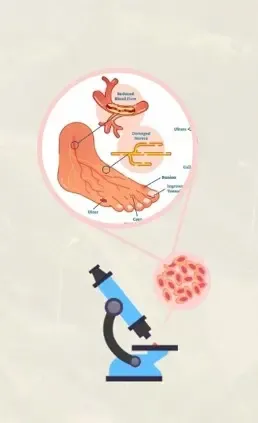Could Sinapic Acid Be the Key to Healing Diabetic Foot Ulcers?

Synopsis
Key Takeaways
- Sinapic acid is a promising natural compound for diabetic wound healing.
- It activates the SIRT1 pathway to promote tissue repair.
- Lower doses of Sinapic acid may be more effective than higher doses.
- This research could lead to affordable treatments for diabetic patients.
- Future clinical trials are planned to further explore its efficacy.
New Delhi, Oct 21 (NationPress) Researchers at Nagaland University have discovered a naturally occurring plant compound known as Sinapic acid, which shows promising potential as a therapeutic agent for enhancing wound healing in individuals suffering from diabetes.
A diabetic wound is characterized as a slow-healing sore, predominantly a foot ulcer, commonly referred to as diabetic foot. This condition heightens the likelihood of complications such as nerve damage (neuropathy), poor blood circulation, infections, and, in severe circumstances, amputation.
This groundbreaking study, published in the journal Nature Scientific Reports, revealed that the oral intake of Sinapic acid can significantly expedite the healing process of diabetic wounds in preclinical models.
Sinapic acid is a natural antioxidant that can be found in a variety of edible plants.
The research indicated that the compound operates by activating the SIRT1 pathway, which is essential for tissue repair, promoting angiogenesis, and controlling inflammation.
This discovery represents a significant breakthrough that could lead to safe, natural, and effective solutions for managing diabetic wounds.
“Diabetes mellitus continues to be one of the most critical chronic health issues worldwide, impacting hundreds of millions. Among its severe complications is delayed wound healing, which may lead to diabetic foot ulcers, infections, and, in extreme cases, amputation. Current synthetic medications have shown limited effectiveness and often result in undesirable side effects,” stated Prof. Pranav Kumar Prabhakar, Head of the Department of Biotechnology at the School of Engineering and Technology at Nagaland University.
“Our findings showed that a lower dose (20 mg/kg) proved more effective than a higher dose (40 mg/kg), a phenomenon referred to as the ‘Inverted Dose-Response’. This not only optimizes dosage strategies but also carries significant clinical implications for future drug development,” he added.
Notably, this discovery could lower the risk of amputation and speed up recovery in diabetic foot ulcers, providing an affordable, natural therapeutic option that enhances accessibility for patients in rural and resource-limited areas.
The research has produced strong preclinical evidence indicating that Sinapic acid improves wound healing, enhances metabolic health, and reduces oxidative stress in diabetic models. The next step involves pilot clinical trials, as per the researchers.










